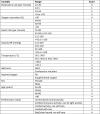Derivation and validation of a clinical severity score for acutely ill adults with suspected COVID-19: The PRIEST observational cohort study
- PMID: 33481930
- PMCID: PMC7822515
- DOI: 10.1371/journal.pone.0245840
Derivation and validation of a clinical severity score for acutely ill adults with suspected COVID-19: The PRIEST observational cohort study
Abstract
Objectives: We aimed to derive and validate a triage tool, based on clinical assessment alone, for predicting adverse outcome in acutely ill adults with suspected COVID-19 infection.
Methods: We undertook a mixed prospective and retrospective observational cohort study in 70 emergency departments across the United Kingdom (UK). We collected presenting data from 22445 people attending with suspected COVID-19 between 26 March 2020 and 28 May 2020. The primary outcome was death or organ support (respiratory, cardiovascular, or renal) by record review at 30 days. We split the cohort into derivation and validation sets, developed a clinical score based on the coefficients from multivariable analysis using the derivation set, and the estimated discriminant performance using the validation set.
Results: We analysed 11773 derivation and 9118 validation cases. Multivariable analysis identified that age, sex, respiratory rate, systolic blood pressure, oxygen saturation/inspired oxygen ratio, performance status, consciousness, history of renal impairment, and respiratory distress were retained in analyses restricted to the ten or fewer predictors. We used findings from multivariable analysis and clinical judgement to develop a score based on the NEWS2 score, age, sex, and performance status. This had a c-statistic of 0.80 (95% confidence interval 0.79-0.81) in the validation cohort and predicted adverse outcome with sensitivity 0.98 (0.97-0.98) and specificity 0.34 (0.34-0.35) for scores above four points.
Conclusion: A clinical score based on NEWS2, age, sex, and performance status predicts adverse outcome with good discrimination in adults with suspected COVID-19 and can be used to support decision-making in emergency care.
Registration: ISRCTN registry, ISRCTN28342533, http://www.isrctn.com/ISRCTN28342533.
Conflict of interest statement
All authors have completed the ICMJE uniform disclosure form at www.icmje.org/coi_disclosure.pdf and declare: grant funding to their employing institutions from the National Institute for Health Research; no financial relationships with any organisations that might have an interest in the submitted work in the previous three years; no other relationships or activities that could appear to have influenced the submitted work. This does not alter our adherence to PLOS ONE policies on sharing data and materials.
Figures
Update of
-
LMIC-PRIEST: Derivation and validation of a clinical severity score for acutely ill adults with suspected COVID-19 in a middle-income setting.medRxiv [Preprint]. 2022 Nov 7:2022.11.06.22281986. doi: 10.1101/2022.11.06.22281986. medRxiv. 2022. Update in: PLoS One. 2021 Jan 22;16(1):e0245840. doi: 10.1371/journal.pone.0245840. PMID: 36380752 Free PMC article. Updated. Preprint.
References
-
- World Health Organisation. Clinical care of severe acute respiratory infections–Tool kit. https://www.who.int/publications-detail/clinical-care-of-severe-acute-re... (accessed 28/04/2020)
-
- International Federation for Emergency Medicine. Global Response to COVID-19 for Emergency Healthcare Systems and Providers: From the IFEM Task Force on ED Crowding and Access Block. https://www.ifem.cc/coronavirus-2019-information/ (accessed 15/06/2020)
-
- NHS. Clinical guide for the management of emergency department patients during the coronavirus pandemic. 17 March 2020 Version 1 https://www.england.nhs.uk/coronavirus/secondary-care/other-resources/sp... (accessed 15/06/2020)
-
- National Institute for Health and Care Excellence. COVID-19 rapid guideline: managing suspected or confirmed pneumonia in adults in the community. Published: 3 April 2020. www.nice.org.uk/guidance/ng165 (accessed 28/04/2020) - PubMed
-
- American College of Emergency Physicians. Guide to Coronavirus Disease (COVID-19) https://www.acep.org/corona/covid-19-field-guide/cover-page/
Publication types
MeSH terms
Grants and funding
LinkOut - more resources
Full Text Sources
Other Literature Sources
Medical





